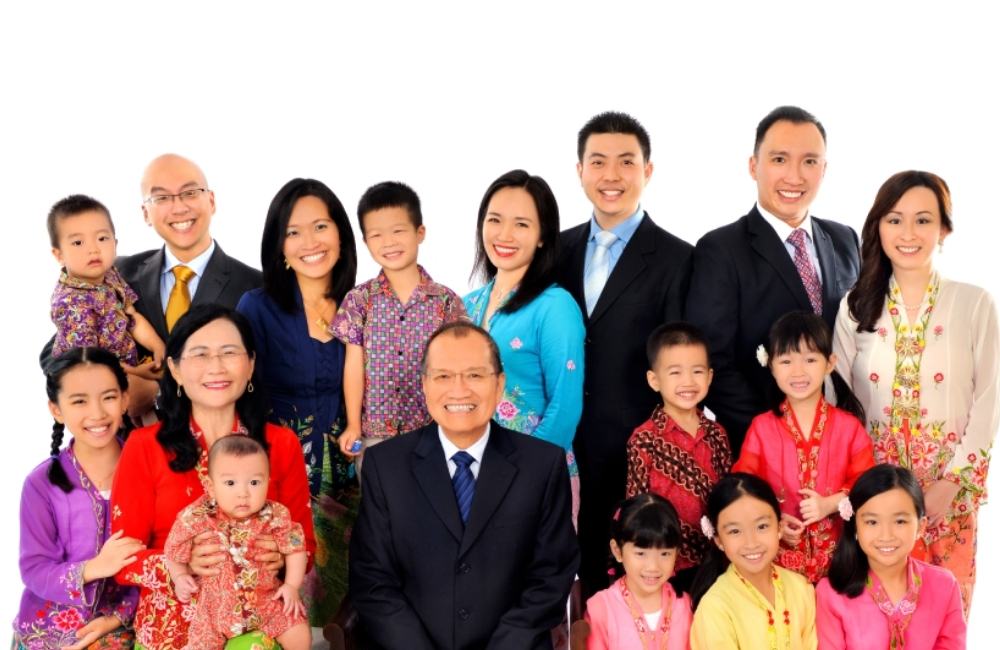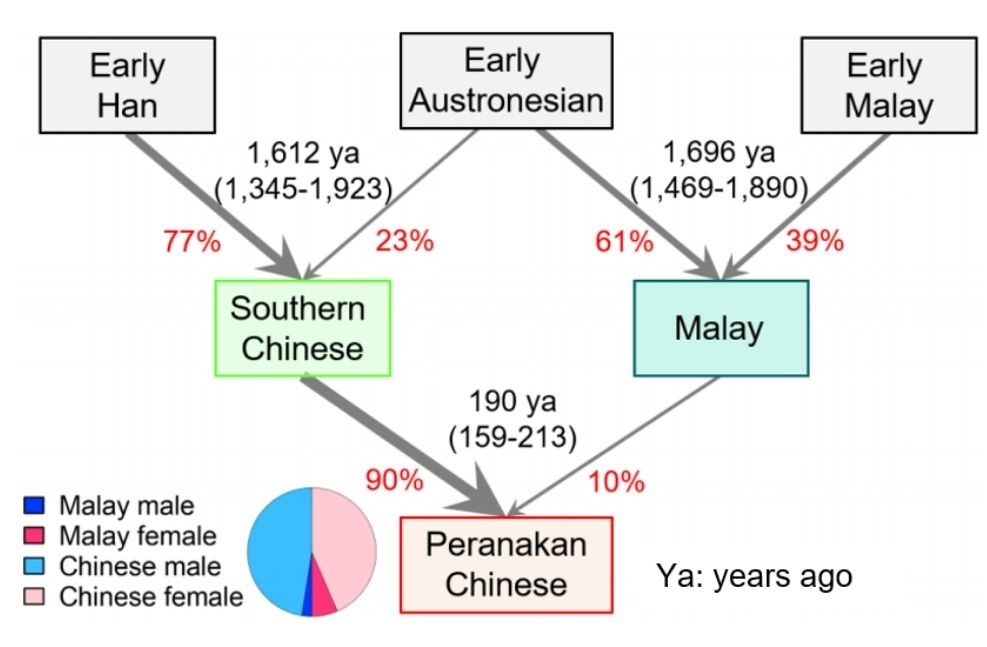Genomic Analysis Of Peranakan Chinese Reveals Insight Into Ancestry
 Three generations of a Peranakan Chinese family in a family portrait. (Photo courtesy of Mr David Ang and Mrs Rose Ang, members of The Peranakan Association)
Three generations of a Peranakan Chinese family in a family portrait. (Photo courtesy of Mr David Ang and Mrs Rose Ang, members of The Peranakan Association)
SINGAPORE – A team of researchers from the Agency for Science, Technology and Research’s (A*STAR) Genome Institute of Singapore (GIS) analysed the genomes of 177 Singapore Peranakans. They estimated that Peranakan Chinese inherited 5.62% Malay ancestry around 190 years ago, a proportion that is significantly higher than that in Singapore Chinese (1.08% Malay ancestry), southern Chinese (0.86% Malay ancestry), and northern Chinese (0.25% Malay ancestry). Their findings were published in the scientific journal Molecular Biology and Evolution on 21 June 2021.
The Peranakan Chinese are culturally unique descendants of immigrants from China who settled in the Malay Archipelago centuries ago. How the genetic admixture of Peranakan Chinese occurred has long been debated and unverified, even within the community. By leveraging DNA sequences (which contain genetic footprints of our ancestors), scientists are now able to infer some aspects of the ancestors of certain populations. This approach could resolve the ambiguities in our demographic histories not covered by historical studies.
Prof Roger Foo, Senior Group Leader of the Laboratory of Molecular Epigenomics and Chromatin Organization at GIS, commented, “Genomes are like books that contain clues about our past, like the ethnicities of our ancestors. By genomic analysis, we have pieced together some clues to reconstruct the pictures of our ancestors.”
The team identified an ancient admixture event shared by the Peranakan Chinese and Singapore Chinese that took place approximately 1,612 years ago, coinciding with the settlement history of Han Chinese in southern China. They also identified the recent admixture event with Malays unique to Peranakan Chinese, which took place around 190 years ago. In addition, they discovered that the Malay ancestry was primarily contributed by Malay females. These results are consistent with the hypothesis that early Chinese traders wedded local Malay women due to the smaller number of Chinese women among the early immigrants.
Baba Colin Chee, President of The Peranakan Association Singapore, said, “The Peranakan Association Singapore is proud to have collaborated with GIS on this ground-breaking genome project. Its findings have, for the very first time, given scientific credence to our belief that the Peranakans descended from the mixed unions of early traders from China, India and Europe with Southeast Asia’s Malay women.”
Prof Patrick Tan, Executive Director of GIS, said, “These findings greatly advance our understanding of the dispersal history of Chinese and their interaction with the indigenous populations in Southeast Asia. The information from the Peranakan genomes provides a welcome addition to our ongoing larger scale efforts to understand the genetic diversity of the Singapore population, and how genetic data can be used to improve the health of every citizen.”
- END -About A*STAR’s Genome Institute of Singapore (GIS)
The Genome Institute of Singapore (GIS) is an institute of the Agency for Science, Technology and Research (A*STAR). It has a global vision that seeks to use genomic sciences to achieve extraordinary improvements in human health and public prosperity. Established in 2000 as a centre for genomic discovery, the GIS pursues the integration of technology, genetics and biology towards academic, economic and societal impact, with a mission to "read, reveal and write DNA for a better Singapore and world".
Key research areas at the GIS include Precision Medicine & Population Genomics, Genome Informatics, Spatial & Single Cell Systems, Epigenetic & Epitranscriptomic Regulation, Genome Architecture & Design, and Sequencing Platforms. The genomics infrastructure at the GIS is also utilised to train new scientific talent, to function as a bridge for academic and industrial research, and to explore scientific questions of high impact.
For more information about GIS, please visit www.a-star.edu.sg/gis.
About the Agency for Science, Technology and Research (A*STAR)
A*STAR is Singapore's lead public sector R&D agency. Through open innovation, we collaborate with our partners in both the public and private sectors to benefit the economy and society. As a Science and Technology Organisation, A*STAR bridges the gap between academia and industry. Our research creates economic growth and jobs for Singapore, and enhances lives by improving societal outcomes in healthcare, urban living, and sustainability. A*STAR plays a key role in nurturing scientific talent and leaders for the wider research community and industry. A*STAR’s R&D activities span biomedical sciences to physical sciences and engineering, with research entities primarily located in Biopolis and Fusionopolis. For ongoing news, visit www.a-star.edu.sg.
NOTES TO EDITOR
ANNEX A
Diagram of the admixture history of Peranakan Chinese
Admixture dates (95% confidence interval 1) and relative contributions from each ancestral source (in red) were obtained from GLOBETROTTER analysis. The admixture event in Malays dated ~1,696 years ago was described in our previous study (Wu, et al. 2019). The 10% contribution from Malay to Peranakan Chinese estimated by GLOBETROTTER was slightly higher than the estimate of 5.62% Malay ancestry using a different method called RFMix. The piechart represents sex-specific contributions, based on mitochondrial and Y-chromosome haplogroups, from Chinese and Malays to the Peranakan Chinese community, assuming equal numbers of males and females in the founders of Peranakan Chinese.
1The confidence interval is a range of values that is likely to include a population value with a certain degree of confidence.ANNEX B
The research findings described in this media release can be found in the scientific journal Molecular Biology and Evolution, under the title, “Genetic admixture in the culturally unique Peranakan Chinese population in Southeast Asia” by the following authors: Degang Wu1, Peter Yiqing Li2,3 Bangfen Pan2,3,4, Zenia Tiang2,3,4 Jinzhuang Dou4, Ivanna Williantarra5,6, Amadeus Yeremia Pribowo6, Rizky Nurdiansyah7, The SG Peranakan Project8, Roger S. Y. Foo2,3,4,* Chaolong Wang1,*
1.Department of Epidemiology and Biostatistics, Ministry of Education Key Laboratory of Environment and Health and State Key Laboratory of Environmental Health (Incubating), School of Public Health, Tongji Medical College, Huazhong University of Science and Technology, Wuhan, China
2.Cardiovascular Research Institute, Yong Loo Lin School of Medicine, National University of Singapore, Singapore
3.NUHS Cardiovascular Diseases Translational Research Program, National University Health System, Singapore
4.Genome Institute of Singapore, Agency for Science, Technology and Research (A*STAR), Singapore
5.Department of Anatomy and Medical Imaging, School of Medical Science, Faculty of Medical and Health Sciences, The University of Auckland, Auckland, New Zealand
6.Department of Biotechnology, Indonesia International Institute for Life Sciences (i3L), Jakarta, Indonesia
7.Department of Bioinformatics, Indonesia International Institute for Life Sciences (i3L), Jakarta, Indonesia
* Correspondence: chaolong@hust.edu.cn (Chaolong Wang), foosyr@gis.a-star.edu.sg(Roger S. Y. Foo).
A*STAR celebrates International Women's Day

From groundbreaking discoveries to cutting-edge research, our researchers are empowering the next generation of female science, technology, engineering and mathematics (STEM) leaders.
Get inspired by our #WomeninSTEM
